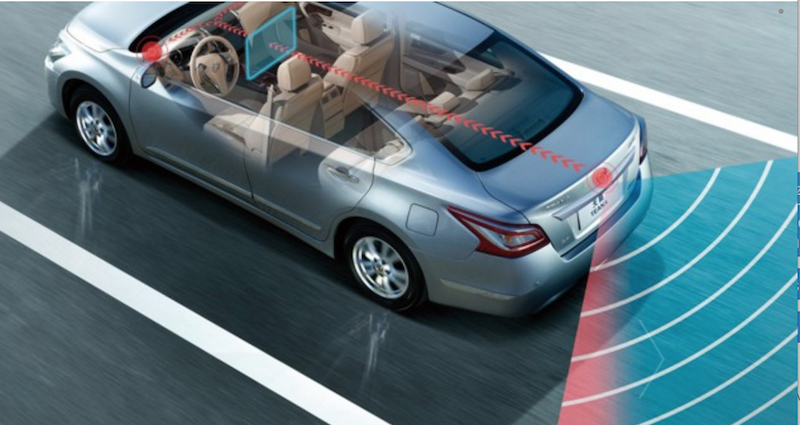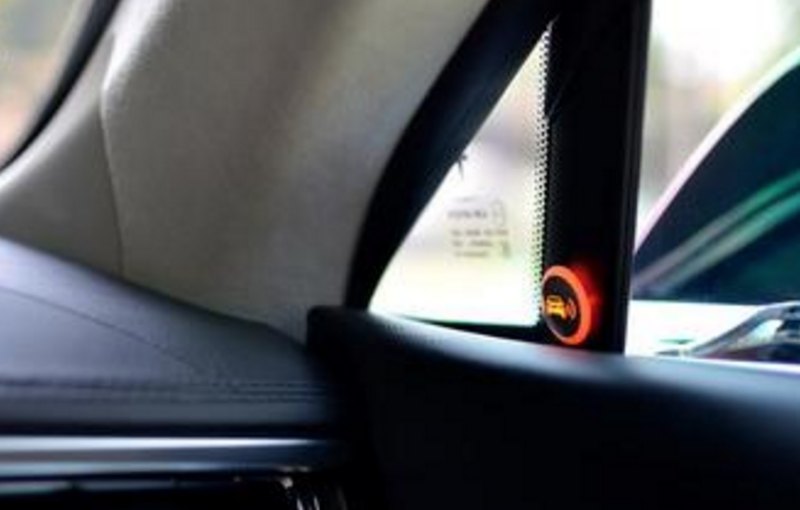How To Update Safety In Older Vehicles

Add safety technology old car with a rear view camera; this Auto Vocalization system attaches right to your rear view mirror. Photo Auto Vox.
Bring Your Onetime Gal Into The Modern Historic period
The boilerplate age of a car on American roads today is 11.five years. That means the average driver is tooling forth without benefit of modern safety technology. But it's possible to bring those old cars up to speed. And it's surprisingly easy and affordable. Some systems are free. Others sell for only a few bucks and can be installed DIY.
Why should you bother? Because safety features have come a long fashion in the last few years. It can be baffling to understand what each system does, merely they make information technology easier to avoid collisions, notice your destination, monitor the systems in your car, even park in tight spots.
After-market versions are available for about all of the smart technology safety features available in new cars. And most are less expensive than the comparable built-in selection on a new machine.
The free options work via apps on your smart phone (navigation and head upwards display are two skilful ones). But be forewarned: using your phone for navigation makes information technology difficult to alter your Spotify playlist.
Here are 10 ways to take your car from old school to space age in no fourth dimension.
1. Collision Avoidance System

Mobileye'due south crash detection organization monitors traffic and alerts the driver of a possible crash. Photo: Mobileye
What information technology does: Detects potential prophylactic hazards to help avert a crash.
How information technology works: A camera, dash-mounted display and, with some systems, sensors embedded in the vehicle's bumper, find traffic, traffic lanes and people or objects effectually you. It gives you a visual warning if traffic slows, if you drift from your lane or if you're speeding (some systems can read speed limit signs).
What it doesn't do: Automatic braking, which is available in most new cars.
Cost and installation: $65+; MobilEye 560 does it all for $850. Unproblematic systems are DIY installation; more sophisticated systems demand a professional.
2. Blind Spot Warning

Blind spot monitors are a neat improver for an older car. Photo: Goshers
What it does: Lets you know if something is in your blind spot.
How it works: Sensors are installed in the front and/or rear bumpers to discover traffic surrounding traffic. Alerts are installed in the machine (usually near the rear view mirrors) and wink when there's something in your blind spot.
What it doesn't exercise: Automatically brake to avoid a collision
Cost and installation: $75+; Goshers bullheaded spot alarm system $250; professional installation recommended.
3. Parking Sensors
What it does: Alerts y'all to low walls, cars or other objects in your path when reversing, parking or making a plow.
How information technology works: Sensors are embedded in the car'south bumpers. A nuance-mounted display signals when the car is dangerously shut to something exterior of a commuter's view.
What information technology doesn't exercise: Automatically restriction earlier y'all hit something.
Cost and installation: $20+; sensors are installed via holes drilled into the car'south bumpers; professional installation recommended.
4. Rear View Camera
What information technology does: Provides a video view from the rear of the automobile when backing up; you can also monitor traffic behind you lot.
How information technology works: A camera is installed in a higher place the rear license plate and sends a video signal to a monitor or your smart phone. Some systems clip on to the rear view mirror (these can include a forward view photographic camera, too), others mountain on the dashboard or can exist wired to an existing touch screen.
What it doesn't do: Record images or automatically restriction when an object is detected
Toll and installation: Photographic camera prices showtime at $15; full systems such as Auto Vox starting time at $130; professional person installation recommended.
5. Engine Diagnostics
What it does: Monitor your car'south health, from the oil level to what the check engine light is telling yous. A smart phone app provides information on alerts, lets yous cheque systems remotely and get reminders when maintenance is due.
How it works: A small device plugs into your car's on-lath diagnostic port (OBD-Two) and a smart phone app lets y'all check your auto's systems or sends a notification if there's an issue.
What it doesn't practice: Monitor not-engine systems such as tire pressure.
Toll and installation: $thirty+; Automobile MD offers a "car health checkup" for used car purchases and estimates repair costs; Hum past Verizon maintains a mechanic hotline to provide fast answers when the arrangement sends an alarm. Installation is simple—just pop the device into your OBD-II port (its location tin can be found online or in your owner's manual).
6. GPS and Navigation
What information technology does: Digital maps and turn by turn directions with visual, voice and real time guidance to your destination.
How it works: At that place are plug and play systems with dash-mounted monitors, in-dash systems and smart phone apps. Many systems accept real time traffic and free map updates.
What information technology doesn't do: Read speed limit signs; speed limit data is pulled from GPS or map information and often doesn't reflect temporary speed limits, such as construction zones.
Cost and installation: $60+; TomTom and Garmin pioneered this space and have a broad range of systems and prices. Most systems are plug and play, but for in-nuance systems, professional installation is recommended.
7. Touch Screen Display
What it does: Like a tablet for your motorcar, touch-sensitive systems let y'all access things similar satellite radio, navigation, a rear view camera or smart phone apps.
How it works: Installed in your car's middle dashboard, it looks and functions just like manufacturing plant installed versions. Touch the screen to choose Apple CarPlay or Android Automobile, set up navigation or set your favorite radio station or playlist.
What it doesn't do: Provide engine diagnostics or control the car'due south other functions, such as climate command.
Cost and installation: $100+; the more features, the college the price. Pioneer's pinnacle of the line versions accept it all for about $one,400. Professional installation recommended.
viii. Tire Pressure level Monitoring System (TPMS)

Know the health of your tires from the condolement of the drivers seat by installing wireless pressure sensors on your tire'due south valves; a monitor in the car lets you know if pressure level is low. Photo: Fullele
What it does: Monitors the air force per unit area in your tires and alerts you lot if pressure is low or you lot have a flat tire.
How information technology works: Sensors in tire valve caps monitor each tire'due south force per unit area and send a bespeak to a base monitor, which plugs into your vehicle'due south cigarette lighter ability port. Some systems too accept a phone app that allows you to monitor tire pressure remotely and get an warning if pressure level is low or if a sensor (or tire!) is missing.
What it doesn't do: Fill your tires with air automatically!
Price and installation: $70+; Fullele'due south system has a small, like shooting fish in a barrel to read monitor and FOBO'south system ($180) is optimized for smart phones and watches. Easy DIY installation.
9. Continued Car Organisation
What it does: These systems allow y'all know where your car is, where it went and how fast it went. You can set "geo-fencing" alerts to know if the car goes exterior a designated area, call for roadside or emergency assistance and make hands-free phone calls.
How it works: A small device plugs into the cigarette lighter power port and clips to your visor or rear view mirror. Push button a button for route side assistance, to request emergency assistance or to make a hands free phone call (the call will play through your car's speakers and a microphone in the unit lets callers hear you).
What it doesn't practice: Relay your automobile's information to the manufacturer.
Toll and installation: $30 plus $10 a month for calls and monitoring; Hum by Verizon's edition likewise includes engine diagnostics. Ready is simple DIY.
10. Head Up Display

Navdy's head upwardly brandish system gathers key information from your auto and phone and projects it onto the windshield in the driver's line of sight. Photo: Navdy
What it does: Displays fundamental driver data, such equally speed, navigation or music on the windshield in forepart of the driver, allowing the driver to keep her head upwards, and eyes on the road.
How information technology works: A small projector mounts on the dashboard in front of the commuter and projects information onto the windshield. Unproblematic systems provide only a few cardinal items, more than advanced systems have a dial that allows you lot to scroll through display choices. Smart phone apps use your phone's screen every bit a projector (a phone mount should be used then your phone doesn't fly off the dash while you're driving).
What it doesn't do: Systems are not hard wired to a car's electric or information organization.
Cost and installation: $15+ for nuance-mount phone holders; basic units are $40+ and Navdy's peak of the line multi-role system is $800. Installation is piece of cake—DIY.
How To Update Safety In Older Vehicles,
Source: https://agirlsguidetocars.com/add-modern-safety-technology-to-your-old-car/
Posted by: byrdbourponshave.blogspot.com


0 Response to "How To Update Safety In Older Vehicles"
Post a Comment